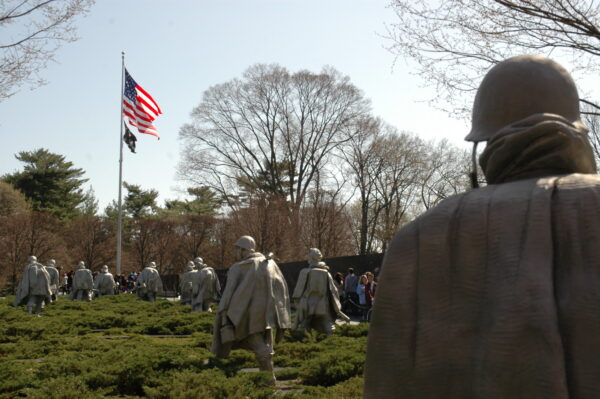
The Korean War Memorial in Washington D.C. (Photo: american_rugbier)
Korean War Veterans Armistice Day, commemorated on July 27, remembers the sacrifice of U.S. Service Members and Veterans who fought for the survival of South Korea. Over 1.7 million Americans served during the war. Nearly 37,000 would never return home.
Prelude to the Korean War
The Korean War marked the first major engagement of the Cold War but has its roots in the aftermath of World War II.
August 15, 1945–July 25, 1950: Imperial Japan Is Defeated and Control of Korea Is Split Between U.S. and Soviet-Controlled Territories
When Imperial Japan unconditionally surrendered to the Allies in 1945, Korea was split — much like Nazi Germany — between the East and West. The United States took command of South Korea, and the Soviet Union controlled the North.
Almost immediately after the 38th parallel was established, the two Koreas erupted into chaos. Border skirmishes, insurgencies, and the broader conflict of the emerging Cold War all worked to increase tension to a fever pitch. By 1949, both superpowers had relinquished control to their respective sides; however, Mao Zedong’s victory in the Chinese Civil War further inflamed tensions while the West looked to contain Stalinist regimes.
Ultimately, five years of perpetual border clashes proved prophetic of the conflict to come.
The Korean War Begins
Historians now debate who fired the first shots of the Korean War, but it remains undisputed that the North Korean People’s Army, or KPA, was the first to engage in a major military campaign. The nascent United Nations was put to the test, ultimately declaring that military force should be used to repel the invasion.
U.S. infantry from the 3rd Battalion hide from enemy artillery somewhere along the Hantan River during the Korean War. (Photo: U.S. Library of Congress)
June 25–Aug. 1, 1950: The KPA Nearly Conquers South Korea
A token U.S. force and a dramatically underdeveloped South Korean military were completely unprepared to fight the KPA, which was largely composed of battle-tested Koreans fighting on behalf of Mao’s China in the recent civil war.
Initially, the KPA was able to conquer all but about 10 percent of South Korea. However, overextended supply lines and the increasingly effective presence of U.S. air power flatlined the KPA’s advance.
Sept. 16–Oct. 19, 1950: U.S.-Led Forces Push the KPA to the Yalu River
Not long after the KPA was forced to abandon its forward positions, a U.S.-led coalition of U.N. forces quickly recaptured South Korea before — despite apprehension from America’s political leadership — eventually moving beyond the 38th Parallel deep into enemy territory.
Barely a month after North Korea had nearly secured victory, it was now looking at its own defeat. U.S. forces occupied North Korea’s capital city of Pyongyang and were pushing the KPA into Chinese territory, but the quick turnaround was tentative.
China was becoming increasingly vocal about intervening in the war, particularly as Allied Commander and World War II hero Douglas MacArthur threatened to invade and bomb North Korea’s closest ally. MacArthur was ultimately dismissed in an attempt to clarify the United States’ political goals, but the move did little to calm tensions with the East.
Oct. 25, 1950–May 22, 1951: China Officially Enters the War and Pushes U.S. Forces Back to the 38th Parallel
With U.S. and Coalition forces on the brink of destroying the KPA, China launched a surprise attack across multiple fronts. Once again, the tide changed, and U.S.-led forces were pushed back below the 38th Parallel.
The gains of yet another invading force were short-lived, though. After Chinese forces found initial success, failed logistics and U.S. air power became insurmountable obstacles for a second time.
July 1951–July 1953: Stalemate and Armistice
By July 1951, the back-and-forth fighting that dominated the first year of the Korean War transitioned to a war of attrition. Through the remainder of the war, both sides would mostly resort to a defensive strategy while political leaders worked to find a face-saving, diplomatic solution.
Two years and two regime changes later, diplomacy ended what military action could not. In early 1953, Dwight D. Eisenhower replaced Harry S. Truman as President of the United States, and only a few weeks later, Soviet leader Joseph Stalin died. Both successors renounced their support for the war, while China was forced to abandon its stance without Soviet support.
On July 27, the United States, South Korea, North Korea, and China signed a peace agreement, unofficially ending the Korean War.
Legacy of the Korean War in America
The Korean War Memorial in Washington D.C. (Photo: U.S. Library of Congress)
The war had a devastating effect on the Korean Peninsula, but limited attention at home led many historians to dub the conflict, “the Forgotten War.” Korean War Veterans Armistice Day was not established until 2019, decades after the agreement was signed.
Per the last U.S. Census in 2019, over a million Korean War Veterans live in the United States. Yet, an official end to the war still proves elusive. North Korea has become one of the most isolated countries in the world under the Kim dynasty, with each new leader resisting any notion of peaceful reunification for this lasting Cold War reminder.